
The Mojave Desert is a xeric desert in the rain shadow of the Sierra Nevada mountains in the Southwestern United States. It is named for the indigenous Mojave people. It is located primarily in southeastern California and southwestern Nevada, with small portions extending into Arizona and Utah.

Acamptopappus is a genus of flowering plants in the family Asteraceae described as a genus in 1873.
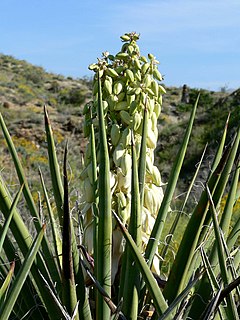
Yucca schidigera, also known as the Mojave yucca or Spanish dagger, is a flowering plant that is native to the Mojave Desert, Chihuahuan Desert and Sonoran Desert of southeastern California, Baja California, New Mexico, southern Nevada and Arizona.

Eriophyllum lanosum, the white woolly daisy or white easterbonnets, is a spring wildflower in the family Asteraceae. It grows in the eastern Mojave Desert and the Sonoran Desert in the southwestern United States and northwestern Mexico.

Monoptilon bellioides, the desert star, also called Mojave desertstar, is a desert flowering plant in the family Asteraceae.

Chaenactis fremontii, with the common names Frémont's pincushion and desert pincushion, is a species of annual wildflower in the daisy family. Both the latter common name, and the specific epithet are chosen in honor of John C. Frémont.

Cirsium neomexicanum is a North American species of thistle known by the common names New Mexico thistle, powderpuff thistle, lavender thistle, foss thistle and desert thistle.

Erigeron aphanactis is a species of flowering plant in the family Asteraceae known by the common name rayless daisy, or rayless shaggy fleabane. This wildflower is native to the western United States, primarily the Great Basin and Colorado Plateau regions.
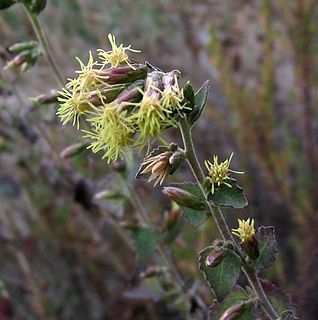
Brickellia californica, known by the common name California brickellbush, is a species of flowering plant in the family Asteraceae.

Ageratina herbacea is a North American species of flowering plants in the family Asteraceae known by the common names fragrant snakeroot and Apache snakeroot. It is native to desert regions of the southwestern United States and northern Mexico. It grows in rocky slopes in conifer forests and woodlands.
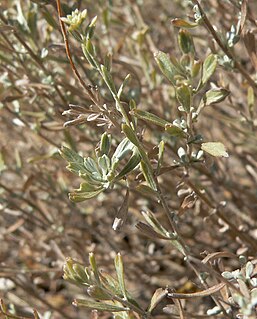
Artemisia bigelovii is a North American species of sagebrush known by the common name Bigelow sagebrush or flat sagebrush. It grows in the deserts of the southwestern United States.

Brickellia desertorum is a species of flowering plant in the family Asteraceae known by the common names desert brickellbush and desert brickellia. It is native to Mexico, Central America, the West Indies, and the southwestern United States.

Brickellia incana is a North American species of flowering plant in the family Asteraceae known by the common name woolly brickellbush. It is native to the Mojave Desert and Sonoran Desert in the southwestern United States, in California, Nevada, and Arizona.

Eriophyllum pringlei is a North American species of flowering plant in the family Asteraceae known by the common name Pringle's woolly sunflower. It is native to the southwestern United States and northern Mexico, where it grows in several types of desert, canyon, and hillside habitat, such as chaparral and sagebrush.
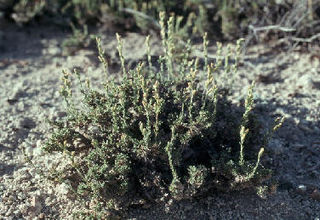
Artemisia pygmaea is a North American species of sagebrush in the aster family known by the common name pygmy sagebrush.

Ericameria paniculata is a species of flowering plant in the sunflower family Asteraceae, native to the southwestern United States. It is an evergreen yellow-flowered desert shrub.
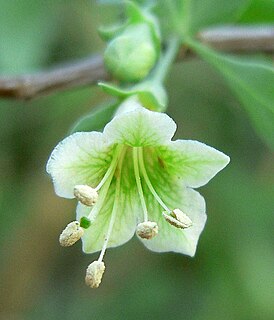
Lycium pallidum is a species of flowering plant in the nightshade family known by the common names pale wolfberry and pale desert-thorn. It is native to northern Mexico and the southwestern United States. In Mexico it can be found in Sonora, Chihuahua, Zacatecas, and San Luis Potosi. In the United States it occurs from California to Texas and as far north as Utah and Colorado.

Ambrosia salsola, commonly called cheesebush, winged ragweed, burrobush, white burrobrush, and desert pearl, is a species of perennial shrub in the family Asteraceae native to deserts of the southwestern United States and northwestern Mexico.

Acamptopappus shockleyi, or Shockley's goldenhead, is a perennial subshrub in the family Asteraceae found in and near the eastern Mojave desert in southern Nevada and southeastern California.



















